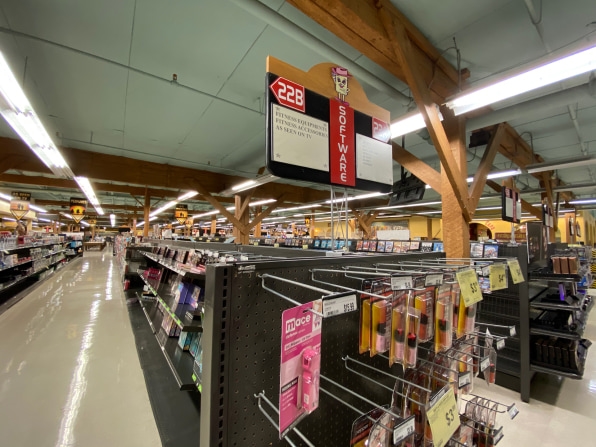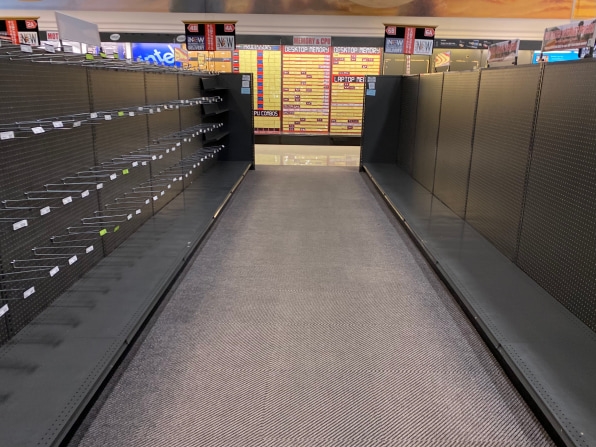Fry’s is dead, and it’s taking part of Silicon Valley culture with it
Fry’s Electronics is no more. The chain of computer and consumer electronics superstores is closing its 31 remaining stores, thereby joining Circuit City, CompUSA, and my own beloved RadioShack among the once-mighty retailers of technology products that went into decline and finally collapsed.
If you live in one of the 41 states that didn’t have a Fry’s, or you don’t consider yourself much of a nerd, this news might mean nothing to you. But for some of us, Fry’s demise—though inevitable—is a shock. (Happily, Micro Center, another venerable chain skewing more to the eastern half of the U.S., is still with us.)
Fry’s eventually had locations as eastward as Indiana, but it began in the Bay Area in 1985, where it was cofounded by three brothers whose father had sold his grocery empire (also called Fry’s) and given them some of the proceeds. Its relationship with Silicon Valley was symbiotic, and its loss feels like a blow to Valley culture as much as a business failure.
Officially, Fry’s is blaming “changes in the retail industry and the challenges posed by the Covid-19 pandemic” for its closure. But it’s clearly been degrading for years. In its boom times, it had more cashiers ringing up purchases than any other store I’ve ever seen, and even then the checkout line was always long and twisty. When the store in Palo Alto, California—where I shopped most often—stopped needing an employee to play traffic cop for this ritual, I knew something was amiss.

In 2019, Fry’s fell off a cliff. Once a technological horn of plenty, the stores suddenly had trouble keeping even a bare minimum of items in stock. The company claimed that this was due to its move to a business model involving taking items on consignment and paying its suppliers only once an item was sold. That might have been true, but the shift appeared to be destroying Fry’s in the process.
Shortly before the pandemic hobbled retail of all kinds, I happened to be in the vicinity of the Fry’s store in Roseville, California, and stopped in. A vast percentage of the sprawling store was empty, with occasional pockets of random products scattered throughout. How the chain clung to life for another year, I’m not sure.
I happened to be near the Fry’s Electronics in Roseville, CA today, so I stopped by to check out the current state of the chain, which is going through some bizarre trauma that has left it largely unstocked.
Warning: This is going to be heartbreaking. pic.twitter.com/w7aEmyoA9q
— Harry McCracken (@harrymccracken) February 17, 2020
Extravagant and charmless
Among the things that made a Fry’s a Fry’s were the extravagant decorations. The Palo Alto location, for instance, had a Wild West theme and featured dummies dressed as cowboys and cowgirls amid the ink-jet printers, car stereos, and big-screen TVs. I’m sorry I never got to the store in Woodland Hills, California, which was based on Alice in Wonderland and looked amazing in photos.
And yet I’d never describe Fry’s as charming. It was famous for its poor customer service: In 1997, Forbes wrote about a “hoops and hurdles” policy designed to discourage customers from returning products. The employees tended to look a tad somnambulant, and it didn’t even occur to me to seek technical advice from them.
Fry’s seemed to regard every customer as a potential shoplifter—it put your purchases in transparent shopping bags, and departing the premises involved showing them and your receipt to a staffer who (in theory) verified that they matched up. When it turned out that the company had been conned out of at least $65 million by an embezzling, Ferrari-driving VP, karmic justice seemed to be at work.
The Horn of Plenty is barren. pic.twitter.com/ycE0EBLHpD
— Harry McCracken (@harrymccracken) February 17, 2020
Even the chain’s tagline—a booming “Your best buys are always at Fry’s!”—was freighted with disappointment. On the whole, its prices didn’t seem any better than anyone else’s—though it was a good place to buy cables without getting gouged.
No, the thing about Fry’s that was exciting wasn’t the shopping experience per se. It was stuff—enormous quantities of gadgets, components, accoutrements, and related items, from the sexy to the mundane to the just plain odd. And for years, that was enough.
When the company went from being a profit machine to a troubled enterprise, I don’t know. (It was privately held and known for its secretive nature.) But the era that made Fry’s essential was long gone. There was the rise of Amazon and other online merchants, of course, which gave geeks access to an even more limitless selection of products, often at lower prices. Fry’s, meanwhile, didn’t seem to take the internet seriously at first; once it launched a real online presence, it was too late to catch up.
Here’s Fry’s computer department, which, truth to tell, was never that great. But at least it used to have computers! pic.twitter.com/7nDWCThAX4
— Harry McCracken (@harrymccracken) February 17, 2020
But it wasn’t just e-commerce that lessened the need for a place such as Fry’s. In the chain’s heyday, the PC was king. When hobbyists weren’t buying new computers, they were upgrading the ones they already owned with goodies such as more RAM, additional storage, and souped-up sound cards. As the industry’s center of gravity moved to sealed-up laptops—and then smartphones—that ecosystem shriveled in importance.
And then there was software—at Fry’s, aisles and aisles of it. Today, we’re far more likely to download apps; even so, the PC software business is a sad shadow of its former self.

For years, it was obvious that Fry’s was struggling to figure out what it should be in less PC-centric times. When it downsized its software section, it filled some of the freed-up space with knockoff fragrances. Even in a store notable for its eclectic offerings—on Twitter, one mourner praised Fry’s fruitcake—that seemed like a stretch.
On an even higher level, Fry’s was a physical manifestation of a Silicon Valley that no longer exists. In the age when it was founded and prospered, the iconic products of the Valley were, indeed, products—from Apple desktop computers to HP laser printers to Seagate hard drives. But this century, the area’s biggest new successes, such as Google and Facebook, got huge fast because their businesses were entirely cloud-based and free to use. You didn’t have to go to Fry’s to get them, which severed the tight relationship between the store and the region that gave it birth.
The Palo Alto Fry’s I habituated closed at the end of 2019, whereupon my own relationship with the company pretty much ended. I’ve managed to survive. But I’m glad I got to see Fry’s in the early to mid-1990s—back when it was about Silicon Valley’s vibrant present and future rather than a remnant of its past.
Fast Company , Read Full Story
(36)

